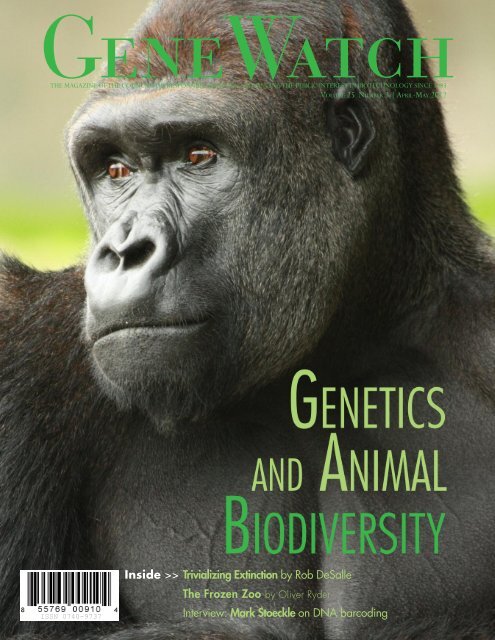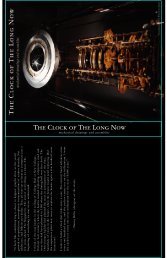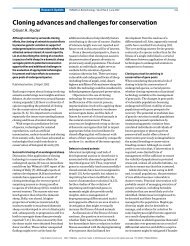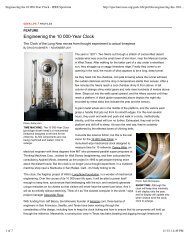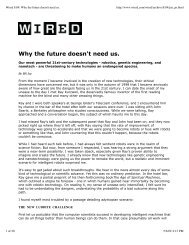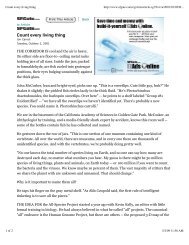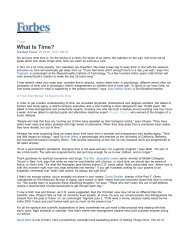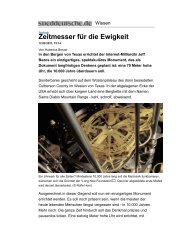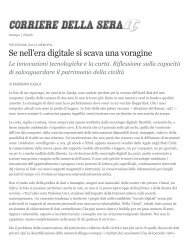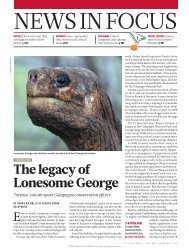The Frozen Zoo - Long Now > Media > Uploader
The Frozen Zoo - Long Now > Media > Uploader
The Frozen Zoo - Long Now > Media > Uploader
You also want an ePaper? Increase the reach of your titles
YUMPU automatically turns print PDFs into web optimized ePapers that Google loves.
GeneWatch<br />
THE MAGAZINE OF THE COUNCIL FOR RESPONSIBLE GENETICS | ADVANCING THE PUBLIC INTEREST IN BIOTECHNOLOGY SINCE 1983<br />
Volume 25 Number 3 | April-mAy 2012<br />
ISSN 0740-9737<br />
Inside >> Trivializing Extinction by Rob DeSalle<br />
<strong>The</strong> <strong>Frozen</strong> <strong>Zoo</strong> by Oliver Ryder<br />
Interview: Mark Stoeckle on DNA barcoding
VoluMe 25 nuMber 3<br />
<strong>The</strong> <strong>Frozen</strong> <strong>Zoo</strong><br />
Wildlife gene banks provide<br />
a tool for studying species and<br />
monitoring conservation efforts.<br />
By olIver ryder<br />
In the course of their work, field<br />
biologists, veterinarians, and zoo<br />
scientists often collect biological<br />
specimens in order to assist ongoing<br />
studies on the biology and health of<br />
species. If, in doing so, they make additional<br />
efforts to bank specimens for<br />
future studies, they provide future<br />
scientists—who may have access to<br />
technologies undreamed of by their<br />
forbears—with opportunities to gain<br />
insights that may contribute to conservation<br />
efforts for declining species.<br />
With the declines in biological<br />
diversity that have been well known<br />
for the better part of a century, these<br />
biobanking efforts have rather quietly<br />
been underway for over thirtyfive<br />
years at the institution where I<br />
work. <strong>The</strong> <strong>Frozen</strong> <strong>Zoo</strong> at the San Diego<br />
<strong>Zoo</strong>’s Institute for Conservation<br />
Research now encompasses gametes,<br />
embryos and cell cultures from<br />
over 9,000 animals, comprising more<br />
than 1,000 species.<br />
<strong>The</strong> frozen cultures of viable cells<br />
may be thawed, grown and divided<br />
into more cells, which can be frozen<br />
again. Although not an infinitely expendable<br />
resource, it provides the<br />
opportunity to conduct studies now,<br />
while still keeping supplies for the<br />
future.<br />
Hundreds of scientific studies<br />
have used samples from the <strong>Frozen</strong><br />
<strong>Zoo</strong>. New species have been identified<br />
after their distinctiveness was revealed<br />
by genetic studies of biobank<br />
GeneWatch 19
samples. Studies of species and individual<br />
identity, for wildlife management<br />
and forensic applications, have<br />
been undertaken and have expanded<br />
the database of DNA profiles and<br />
barcodes. Infertile animals have been<br />
identified from genetic testing, parentage<br />
relationships identified and<br />
incorporated into species management<br />
programs; and now, whole genome<br />
sequencing and studies of the<br />
repertoire of expressed genes—the<br />
“transcriptome”—are being studied<br />
using samples banked over the last<br />
four decades. From most of the small<br />
population management programs<br />
of zoos, questions have arisen that<br />
are answerable by genetic testing, if<br />
appropriate samples are available.<br />
<strong>The</strong> <strong>Frozen</strong> <strong>Zoo</strong> has played a crucial<br />
role in all these activities.<br />
Opportunities for the future<br />
Before Dolly, the sheep cloned<br />
by Dr. Ian Wilmut’s team in 1996,<br />
most scientists—myself included—<br />
considered that the differentiated<br />
adult cells of the body could not be<br />
reprogrammed and proceed again<br />
through or guide the mammalian<br />
development. It was a surprise<br />
again when Dr. Shinya Yamanaka’s<br />
team demonstrated that cultured<br />
fibroblast (skin) cells could be reprogrammed<br />
by transiently activating<br />
as few as four genes introduced<br />
into these cells. If the techniques for<br />
producing induced pluripotent stem<br />
cells (iPS, cells capable of becoming<br />
any cell type in the body) could be<br />
adapted to provide similar results<br />
with fibroblasts from many other<br />
species, the <strong>Frozen</strong> <strong>Zoo</strong> potentially<br />
represents the source of the largest<br />
and most diverse collection of stem<br />
cells anywhere.<br />
After more than a year of dedicated<br />
work, Dr. Inbar Ben-Nun, in<br />
Professor Jeanne Loring’s group<br />
at <strong>The</strong> Scripps Research Institute,<br />
and a team from U.C. San Diego<br />
and the San Diego <strong>Zoo</strong> Institute for<br />
Conservation Research announced<br />
the production of iPS from two endangered<br />
species, the drill and the<br />
northern white rhinoceros. <strong>The</strong> drill<br />
is a large African monkey with a declining<br />
population in U.S. zoos and<br />
endangered in its habitats in Cameroon<br />
because of habitat loss and illegal<br />
poaching. <strong>The</strong> northern white<br />
rhinoceros is the most endangered<br />
form of rhinoceros. Studies of skull<br />
characteristics and genetics analyses<br />
resulted recently in this African<br />
rhinoceros being named a separate<br />
species, distinct from its southern<br />
relatives.<br />
<strong>The</strong>se studies demonstrate the<br />
potential for stem cells to be used in<br />
veterinary medicine and for treating<br />
illnesses. <strong>The</strong> question also arises of<br />
the potential for applying new approaches<br />
in assisted reproductive<br />
technologies. <strong>The</strong>se might include<br />
producing sperm and eggs in tissue<br />
culture flasks, the production of embryos,<br />
and down the road, northern<br />
white rhino babies. But it is a long<br />
road to travel. Time is running out<br />
for the northern white rhino, and although<br />
it may be one of the last tools<br />
remaining, technology may not be<br />
sufficient to prevent its extinction.<br />
Impacts of induced pluripotency<br />
It is altogether reasonable that we<br />
pause and consider what we might<br />
do, for what reason, and for whose<br />
benefit.<br />
<strong>The</strong> use of DNA banks to produce<br />
living animals, restore to life extinct<br />
species, and provide novel life forms<br />
is entrenched in popular musings.<br />
<strong>The</strong> broadly reported effort to clone<br />
a mammoth seems to be known by<br />
people of all ages.<br />
Given the limitations of our times<br />
and our global society in addressing<br />
the declines in biological diversity<br />
and loss of species, should we strive<br />
to produce a living animal that went<br />
extinct ten thousand years ago?<br />
Could it play a role today as it did in<br />
its native ecosystem?<br />
If the motivation for developing<br />
advances in assisted reproductive<br />
technologies were to be based on<br />
preventing ongoing losses of biological<br />
diversity and reducing the risk<br />
of extinction of species that have<br />
undergone dramatic recent declines<br />
because of human activities, the investments<br />
and benefits would reflect<br />
a different set of values.<br />
<strong>The</strong> way to sustain and conserve<br />
species is in natural habitats. However,<br />
without invoking additional<br />
and alternative strategies, losses of<br />
biological diversity will surely be<br />
large, for many species continue to<br />
disappear from their habitats.<br />
<strong>The</strong> controversies that arise<br />
around the discussions of conservation<br />
strategies and methods stand in<br />
a different realm from the efforts of<br />
museums, zoos, and research institutes<br />
to prospectively bank biological<br />
samples that can assist conservation<br />
assessments, monitoring and management.<br />
Efforts devoted to banking<br />
cells desperately need to be expanded<br />
by and for the global community.<br />
nnn<br />
Oliver A. Ryder, PhD, is Director of Genetics<br />
at the San Diego <strong>Zoo</strong> Institute for<br />
Conservation Research and an Adjunct<br />
Professor of Biology at <strong>The</strong> University of<br />
California, San Diego.<br />
20 GeneWatch april-May 2012


